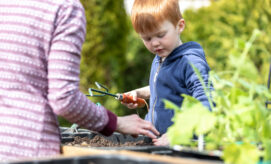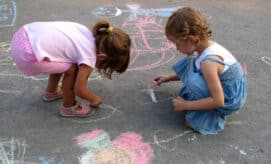In response to COVID-19, many early learning programs are trying to move more of their curriculum and activities outside. Outdoor learning takes advantage of fresh air and open spaces to help early childhood educators meet new guidelines and requirements for social distancing.
While most programs have time outside included in their curriculum, building an outdoor classroom goes one step further by prioritizing time spent outside. Curriculum and classroom materials typically worked on indoors are taken outside to be enjoyed in nature.
Developmental Benefits
In addition to providing a solution to social distancing challenges, outdoor learning offers many benefits for children’s learning. Researchers have found that when children learn outdoors, they engage in more creative play, stay healthier, and master skills in self-discipline, decision-making and problem-solving. Exploring and enjoying the outdoors also encourages children to view the world in a way that leads to strong environmental attitudes and civic behaviors.
Learning from The Forest School Approach
While outdoor classrooms are new to many early learning professionals, some programs practice their entire curriculum outside. These outdoor programs can be a source of inspiration and ideas for programs interested in moving more learning outdoors. One of the most popular curriculum models is called the forest school approach.
Some forest school core principles can be easily borrowed and tailored to your program’s outdoor learning goals, including…
-
Play-based, child-directed learning: Children learn as they play! Rather than teachers planning lessons for the day, children take the lead and engage in free-play. Teachers and caregivers support children’s natural interests by following their lead, and working alongside the children to support their learning.
-
Hands-on interactions with the environment: Children enjoy interacting with nature! From playing in the mud, to building with sticks, teachers and caregivers encourage children’s opportunities to work with natural materials and connect with the environment.
-
Emphasis on community and collaboration: By playing together, children learn to problem-solve, communicate, share ideas, and learn from each other. Forest schools are inclusive and welcoming to the diverse interests, needs, and backgrounds of their community members.
Learning & Play
Creating an outdoor classroom might sound like a big task, but there are ways that you can conveniently shift parts of your day outside.
Circle Time & Story Time
If you typically do circle time indoors, you might consider shifting it to outside. All you will need to bring outside are items (such as a large tarp, towels, blankets, etc.) to form a circle for children to sit in, and a few books that work well for reading aloud. Doing this activity outside will also allow children to spread out more than they would be able to indoors.
Children’s favorite books and stories can easily be brought outdoors for individual enjoyment. You might select a few books from your library to bring outside, or you can bring a few new books outside every morning and return them to the classroom at night.
Natural Materials







